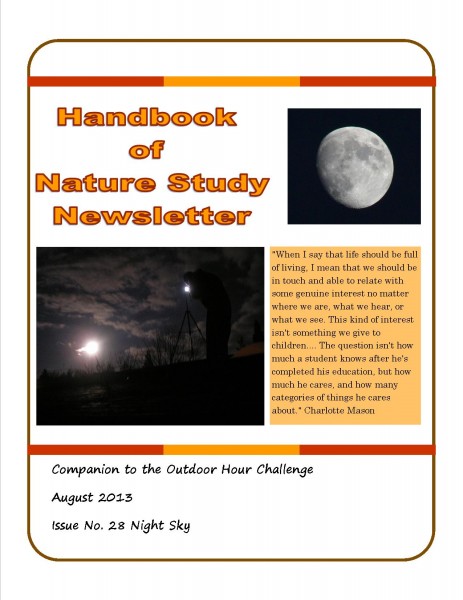The night sky is a fascinating subject to study. Over the years we’ve used our powers of observation to notice so many things right from our own back deck. We have a fairly dark neighborhood so gazing at the stars is a bit easier than if we lived in the city. My youngest child has always had an interest in learning about space and the universe, so hooking him into a little nature study at night has been easy and fun. We further nurtured his curiosity by creating a high school astronomy course that fit his needs and interests.

Tips for a Night Sky Study
* It takes a long time for your eyes to adjust to being outside at night. I read it takes 30 minutes, so allow enough time to get your “night vision” working before you start to look for stars.
* Have a good glow in the dark type constellation chart and know where your compass points of reference are while standing at your observation spot. This will make it easier to orientate your star chart to the sky.
“Geology, mineralogy, physical geography, botany, nature, biology, astronomy–the entire realm of science is like a beautiful fenced green field and we need to bring the child to the gate and leave it open for him. He doesn’t need a thorough collection of facts. He needs what Huxley calls ‘common information’ so that he’ll feel some connection with things on the earth and in the heavens.” Charlotte Mason
* Don’t expect too much at first. It takes time to learn the basics like where the Big Dipper, Little Dipper, and North Star are to be found during each season. Take it slowly and realize you have many years of stargazing to learn more.
* Dress appropriately! It is cold at night for a large part of the year so bundle up. Have a blanket to wrap in or to lay on for stargazing.
* Spend some time viewing the night sky and watching for meteorites, satellites, and airplanes. This is a fun activity because they move across the sky and are easy to spot.
* Get the whole family involved and take turns pointing constellations out. Our family became really good at this by using a free iPhone app called Sky Map. It allows you to point your phone at the sky and identify the objects you can see using a GPS system. Fun! (There is also an Android app—Google Sky Map.)
* Binoculars on a tripod are a great alternative for amateur stargazing.
Look for a Local Observatory
* We visited our local observatory several times a year and enjoyed the help and explanations of the volunteer docents. It was great to get one on one time with astronomers and students who were willing to share their knowledge with interested children.

Keep a Journal
* Keeping a journal is an excellent way for older children to learn more about the night sky. We didn’t require a journal entry every time we completed an observation but only when there was something interesting to note.
I created a high school level course for my son to complete during his 11th grade year. See the details and suggestions here:
The link above will share all the resources we used to make astronomy a living science course.
If your children are young, remember that you’re trying to build interest in the night sky, make them curious to know more, and to build an appreciation for all that they see.
Please note that the August 2013 Newsletter in the archives contains lots of ideas to help with a night sky study. Members can find it in their library for download.

You can use the discount code NATURE5 to receive $5 off your Ultimate Naturalist Library membership.


